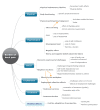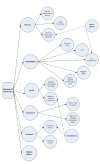A validity-driven approach to the understanding of the personal and societal burden of low back pain: development of a conceptual and measurement model
- PMID: 21933393
- PMCID: PMC3308082
- DOI: 10.1186/ar3468
A validity-driven approach to the understanding of the personal and societal burden of low back pain: development of a conceptual and measurement model
Abstract
Introduction: While the importance and magnitude of the burden of low back pain upon the individual is well recognized, a systematic understanding of the impact of the condition on individuals is currently hampered by the lack of an organized understanding of what aspects of a person's life are affected and the lack of comprehensive measures for these effects. The aim of the present study was to develop a conceptual and measurement model of the overall burden of low back pain from the individual's perspective using a validity-driven approach.
Methods: To define the breadth of low back pain burden we conducted three concept-mapping workshops to generate an item pool. Two face-to-face workshops (Australia) were conducted with people with low back pain and clinicians and policy-makers, respectively. A third workshop (USA) was held with international multidisciplinary experts. Multidimensional scaling, cluster analysis, participant input and thematic analyses organized participants' ideas into clusters of ideas that then informed the conceptual model.
Results: One hundred and ninety-nine statements were generated. Considerable overlap was observed between groups, and four major clusters were observed--Psychosocial, Physical, Treatment and Employment--each with between two and six subclusters. Content analysis revealed that elements of the Psychosocial cluster were sufficiently distinct to be split into Psychological and Social, and a further cluster of elements termed Positive Effects also emerged. Finally, a hypothesized structure was proposed with six domains and 16 subdomains. New domains not previously considered in the back pain field emerged for psychometric verification: loss of independence, worry about the future, and negative or discriminatory actions by others.
Conclusions: Using a grounded approach, an explicit a priori and testable model of the overall burden of low back pain has been proposed that captures the full breadth of the burden experienced by patients and observed by experts.
Figures



Similar articles
-
The burden of neck pain: its meaning for persons with neck pain and healthcare providers, explored by concept mapping.Qual Life Res. 2016 May;25(5):1219-25. doi: 10.1007/s11136-015-1149-6. Epub 2015 Oct 14. Qual Life Res. 2016. PMID: 26466835 Free PMC article.
-
Right care, first time: a highly personalised and measurement-based care model to manage youth mental health.Med J Aust. 2019 Nov;211 Suppl 9:S3-S46. doi: 10.5694/mja2.50383. Med J Aust. 2019. PMID: 31679171
-
Subgrouping for patients with low back pain: a multidimensional approach incorporating cluster analysis and the STarT Back Screening Tool.J Pain. 2015 Jan;16(1):19-30. doi: 10.1016/j.jpain.2014.10.004. Epub 2014 Oct 22. J Pain. 2015. PMID: 25451622 Free PMC article.
-
Content and psychometric evaluations of questionnaires for assessing physical function in people with low back disorders. A systematic review of the literature.Disabil Rehabil. 2020 Jan;42(2):163-172. doi: 10.1080/09638288.2018.1495274. Epub 2018 Oct 16. Disabil Rehabil. 2020. PMID: 30324809
-
Psychological factors in disabling low back pain: causes or consequences?Disabil Rehabil. 1996 Apr;18(4):161-8. doi: 10.3109/09638289609166295. Disabil Rehabil. 1996. PMID: 8744903 Review.
Cited by
-
The Relationship between Health Literacy and Health Behaviour in People with Diabetes: A Danish Population-Based Study.J Diabetes Res. 2016;2016:7823130. doi: 10.1155/2016/7823130. Epub 2016 Sep 28. J Diabetes Res. 2016. PMID: 27761473 Free PMC article.
-
The health literacy questionnaire among the aged in Changsha, China: confirmatory factor analysis.BMC Public Health. 2019 Sep 4;19(1):1220. doi: 10.1186/s12889-019-7563-x. BMC Public Health. 2019. PMID: 31484512 Free PMC article.
-
Application of validity theory and methodology to patient-reported outcome measures (PROMs): building an argument for validity.Qual Life Res. 2018 Jul;27(7):1695-1710. doi: 10.1007/s11136-018-1815-6. Epub 2018 Feb 20. Qual Life Res. 2018. PMID: 29464456 Free PMC article.
-
Enhancing the Effectiveness of Consumer-Focused Health Information Technology Systems Through eHealth Literacy: A Framework for Understanding Users' Needs.JMIR Hum Factors. 2015 May 20;2(1):e9. doi: 10.2196/humanfactors.3696. JMIR Hum Factors. 2015. PMID: 27025228 Free PMC article.
-
The burden of neck pain: its meaning for persons with neck pain and healthcare providers, explored by concept mapping.Qual Life Res. 2016 May;25(5):1219-25. doi: 10.1007/s11136-015-1149-6. Epub 2015 Oct 14. Qual Life Res. 2016. PMID: 26466835 Free PMC article.
References
-
- World Health Organisation. The burden of musculoskeletal conditions at the start of the new millennium. World Health Organ Tech Rep Ser. 2003;919:i–x. 1-218, back cover. - PubMed
-
- Hoy D, Bain C, Williams G, March L, Brooks P, Blyth F, Woolf A, Vos T, Buchbinder R. Global prevalence of low back pain. Arthritis Rheum. 2011. in press . - PubMed
-
- Rapoport J, Jacobs P, Bell NR, Klarenbach S. Refining the measurement of the economic burden of chronic diseases in Canada. Chronic Dis Can. 2004;25:13–21. - PubMed
Publication types
MeSH terms
LinkOut - more resources
Full Text Sources
Medical

